HOREZU, Romania — Sorin Giubega’s grandfather was a potter.
So was his father. And at eight years old, Giubega said, he started to play on
a pottery wheel, too.
اضافة اعلان
Giubega, now 63, and his wife, Marieta Giubega, 48, are
potters in Horezu, Romania, a town in the foothills of the Capatanii Mountains
about three hours by car from Bucharest.
Horezu is home to a community of about 50 artisans who make
a traditional style of ceramics with methods that have been practiced for more
than 300 years. In 2012, Horezu pottery was recognized as an Intangible
Cultural Heritage of Humanity by UNESCO, the UN Educational, Scientific and
Cultural Organization.
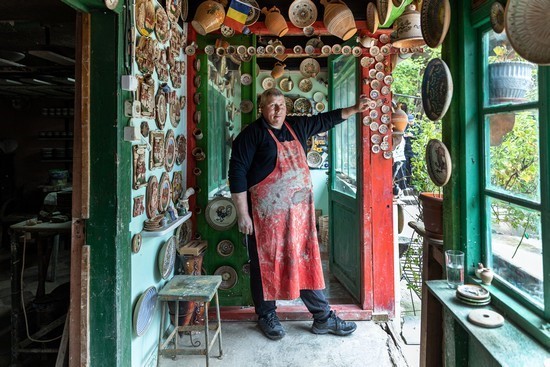
Most potters in Horezu, including the Giubegas, live on
Olari Street (“olari” means potters in Romanian), where they work in home
studios. The artisans advertise their craft by hanging ceramic plates outside
their houses, some of which have yards where they keep roosters and pigs.
On a Monday afternoon in early May, Giubega, who was wearing
a clay-caked apron, showed off a shelf of ceramic honey pots and jam jars that
his grandfather had made in the 1920s.
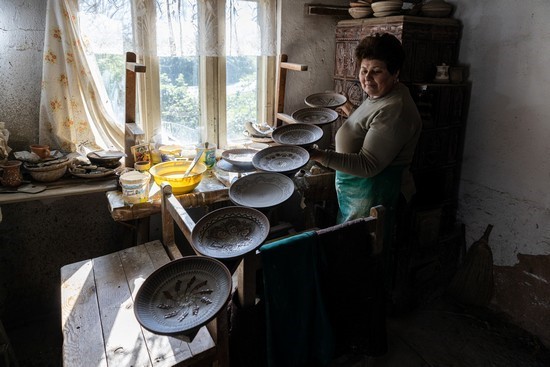
“This is the story of my life!” said Giubega, who was named
a Living Human Treasure by Romania’s Ministry of Culture in 2021.
Traditional techniques
Artisans in Horezu work year-round, and the ceramics are
made by two potters with distinct roles. Modelers, who are typically men, shape
clay into pieces. Decorators, who are typically women, paint the pieces using
ancestral motifs that include spirals, waves, spider webs, roosters, serpents,
fish, and an arboreal design known as the tree of life, which is dotted with
apples.
“We are all doing the same thing, but we each have our own
style,” said Aida Frigura, 44, a potter in Horezu who specializes in
decorating. “It’s like handwriting.”
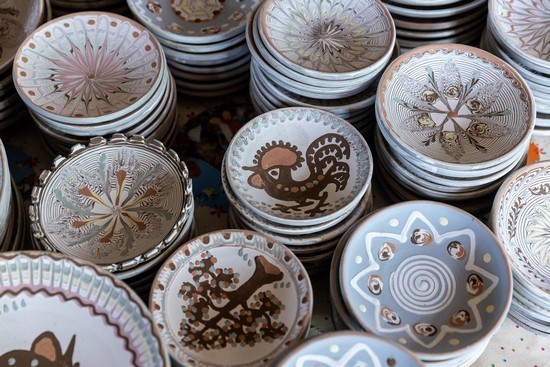
Many modelers and decorators, including the Giubegas, are
married couples. Constantin Biscu, 49, and his wife, Mihaela Biscu, 42, make
pottery at their home on Olari Street, where he works at a kick wheel on which
he can make up to 300 pieces in a day, he said.
“It’s hard, it’s dirty,” Biscu said of the clammy gray clay
that he and others used, which customarily comes from earth extracted from a
hill in Horezu. Many potters’ families have owned parcels of the hill for
generations.
Decorators also work at wheels and with specialized tools,
such as one instrument that resembles a fountain pen. It is made with an ox
horn and quills from goose or duck feathers, and it is used to draw certain
designs and to apply paints, which are typically muted hues of green, blue,
ivory, red, and brown. Potters formulate their own paints using copper and
cobalt powders, as well as minerals found in the area.

To create intricate patterns such as the spider web,
decorators use two other tools: a brush with bristles made of cat whiskers or
boar hair, and a twig with a metal pin on one end.
Once pieces are decorated and fully dried, they are loaded
into a kiln and fired for hours. After that, they are glazed and fired again.
Vessels in Vogue
This month, many of the potters in Horezu will showcase and
sell their wares at two folk art fairs in Romania.
The first, the Cocosul de Hurez, or Rooster of Horezu, is a
local ceramics fair named for the bird that residents of the town see as
symbolic of the home. The second, the Cucuteni 5000, is a national ceramics
fair that takes place in Iasi, some eight hours by car from Horezu. It is named
for the Cucuteni people, who, around 5000 BC, started to make decorated pottery
in what is now Romania.
In recent years, as interest in ceramics has grown, pottery
from Horezu has started to appear at more trendy design-oriented retailers
around the world, including Lost & Found in Los Angeles; FindersKeepers in
Copenhagen; International Wardrobe in Berlin; Cabana in Milan; and Casa De
Folklore in London.
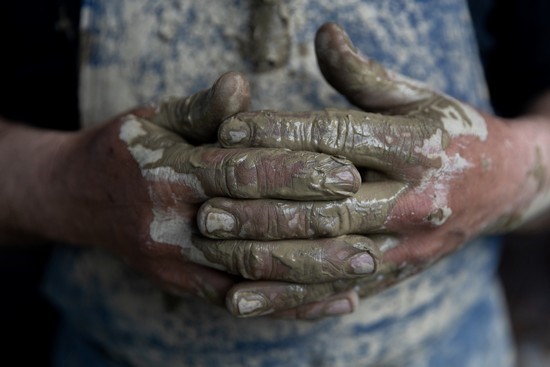
“Demand is really high at the moment,” Alice Munteanu, the
Romanian-born owner of Casa De Folklore, said on a video call. She recently
sold tableware made in Horezu to the owners of Clover, a restaurant in Paris.
Munteanu said the décor industry was fond of artisanal work right now, adding
that if it was “obscure” — she used air quotes — that was even better.
Herle Jarlgaard, an owner of FindersKeepers, first
encountered the pottery in 2021 at a flea market in Italy, where she found a
plate painted with trippy marbled rings and dots along the rim. On its
underside was the word “Horezu”.
“Whoa!” Jarlgaard, 35, recalled thinking after seeing the
plate.
When she tried to contact potters in Horezu, Jarlgaard had a
hard time at first. She eventually connected with Maria Stefanescu, a
decorator, via the Instagram account that Stefanescu’s son, a police officer in
Bucharest, had created to promote his mother’s work.
FindersKeepers has since started to buy ceramics wholesale
from Stefanescu, a decorator who works with a modeler she is not related to.
The retailer, which buys hundreds of pieces at a time, has paid her about
$50,000 for its orders to date, Jarlgaard said.
Modern concerns
UNESCO’s designation of Horezu pottery as an intangible
cultural heritage was a proud moment for Romania, said Virgil Nitulescu,
director of the Museum of the Romanian Peasant in Bucharest. Corina Mihaescu,
an anthropologist at the Institute of Ethnography and Folklore in Bucharest,
said the UNESCO recognition had led more young people to take up the craft.
To maintain the designation, a state-of-the-craft report
must be submitted every six years to UNESCO. The report explains, among other
things, what measures have been taken to keep the tradition of Horezu pottery
alive and what tools and techniques the potters are using.
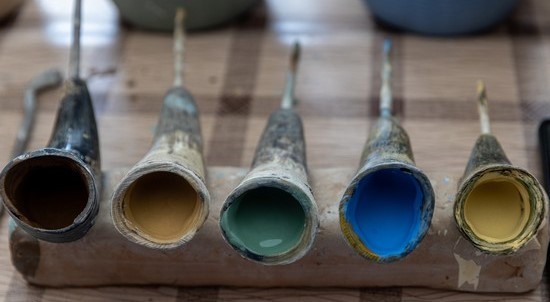
Mihaescu produced the most recent state-of-the-craft report,
which was submitted last year by Romania’s Ministry of Culture. She said there
were always concerns about how to retain the UNESCO designation — and maintain
the integrity of the pottery tradition — in the face of modern influences.
To comply with European regulations limiting the use of
heavy metals such as lead and cadmium in glazes for ceramics that may come in
contact with food, many potters now use electric kilns instead of wood-burning
ones. The electric kilns can more reliably reach the higher temperatures —
around 1,037°C — necessary to fire food-safe glazes.
Other potters in Horezu have begun to use ready-made clay
instead of preparing their own. And certain decorators have started to paint
the pottery in unconventional motifs and colors; Stefanescu, for instance, has
used bright red as well as yellow and pink. Some of the newer designs are
requested by vendors outside Romania, many of whom tend to avoid ancestral
motifs featuring animals and prefer bolder and monochrome palettes.
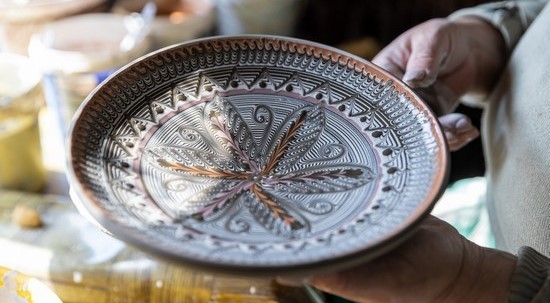
“We say, ‘Our client, our master,’ but I have final say,”
Stefanescu said. Of incorporating atypical colors into her pieces, she added,
“I like to try new things.”
Constantin Popa, 62, who makes pottery in Horezu with his
wife, Georgeta Popa, 57, said they tried to fulfill clients’ wishes as much as
possible. But according to him, painting pieces in saturated colors has
“nothing to do with Horezu.”
Read more Lifestyle
Jordan News








